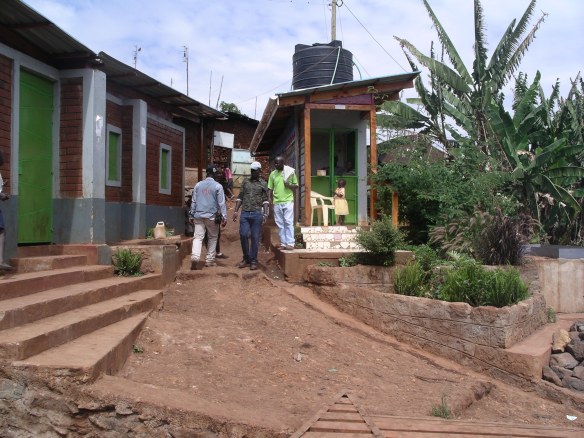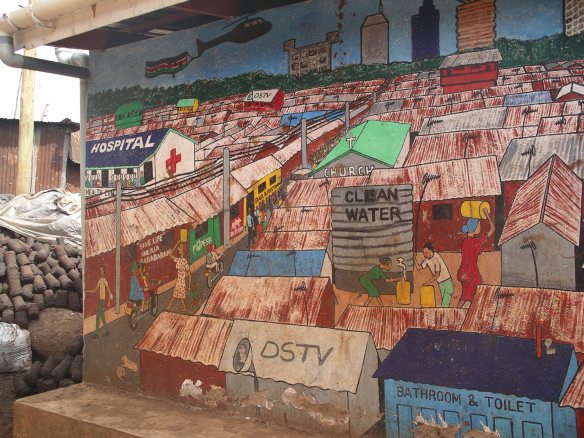Recently, Nairobi Planning Innovations caught up with proud Kibera resident Ibra Maina. Ibra has been involved with the Kounkuey Design Initiative (KDI) in Kibera for many years. KDI is an innovative international partnership that draws on architecture, landscape architecture, engineering, and urban planning to build partnerships with residents to create low-cost, high-impact built environments (Productive Public Spaces). You can review some of their projects here. Ibra recently conceptualized and help catalyze the production of a moving film “We have Life” which won the Rockefeller Storytelling Challenge. We recommend you watch it!

The Kibera Public Space Project has created beautiful and useful public spaces
NPI: You are a proud resident of Kibera. What about your neighborhood do you like the most?
Having been born and brought up in Kibera, I am really proud to be a Kibera resident. For me, I love our unity and the social life within us that you can’t find anywhere else. The strength and power that exists amongst us is unlike anywhere else. We are very creative and motivated, and most of all we are very passionate about positive change. More than anything else, these are the very important things that make us feel great about our great neighbourhood called Kibera.
NPI: What would you focus on to improve your neighborhood?
To improve your neighbourhood, you always need to have a positive approach towards development. Perfection is impossible, but progress is always promising. You should be real and remain focused towards real issues that can cause change, and always be confident in your work and ideas.
NPI: You have been critical of the way the mass media tends to portray Kibera and this helped inspire the beautiful film “We have a Life”. What advice would you give journalists who wish to cover Kibera’s affairs?
Over the years, there have been many stories written about Kibera and its residents. These stories often portray the settlement in very negative way. My experience living and working with communities that are pro-development in Kibera tells a different story about my beautiful settlement. In “We have a Life,” we embraced the positive, community-led change in Kibera. Just like any other city we, the residents of Kibera, face a few challenges. Even in the city of New York for example people face challenges like crime and poverty, homelessness and hunger. My advice to learned journalist is focus on sharing positive initiatives and changes that showcase that we all have a life and that we all have ideas and solutions to the challenges that face us all. The people of Kibera have taken the responsibility to advocate and drive development that they wish to see. The youth and women, the residents and leaders are becoming the change they want. They have shown the capacity to manage projects that continue to positively impact their communities. Writing such stories demonstrates that we are not just improving our city of Kibera, but offering solutions for the same challenges in other parts of the world.

Public art is part of the Kibera Public Space Project
NPI: You have been centrally involved in long term and award winning work to improve the quality of public space and facilities in Kibera through the Kounkuey Design Initiative. Can you describe this work and what it means to you?
To realise this dream and vision, we have always worked very, very closely and collaboratively with the communities and residents to empower them to physically transform their environment by building what we call productive public space projects. Our process is community-driven; this process empowers the residents to participate and ensure that the end goal is accepted, owned, and sustained by the community. A challenge is complex: it is economic, social and physical. Where possible, we connect residents to local and county-level institutions that ensure that their work is rooted in networked and sustainable change.
NPI: The National Youth Service has been heavily involved in projects in Kibera. How has this been going from your perspective as a long time resident and designer? What advice would you give to the NYS to improve their work?
Personally I like the idea of NYS projects in informal settlements. The program managed to bring a number of youths together to provide organised manpower. The NYS program created job opportunities for the youths and the residents, while reducing idleness amongst the youths and crime. Our environment was conserved well through the cleaning activities that were being undertaken by the youths. What I would advise is that the programme should detail and implement a strong exit plan so that the projects and its programmes that benefit the community are well transitioned for ownership and sustainability. Through a community-driven process, the programme should have carefully measured community needs through a baseline survey and need assessment strategy prior to commencing any physical interventions.
